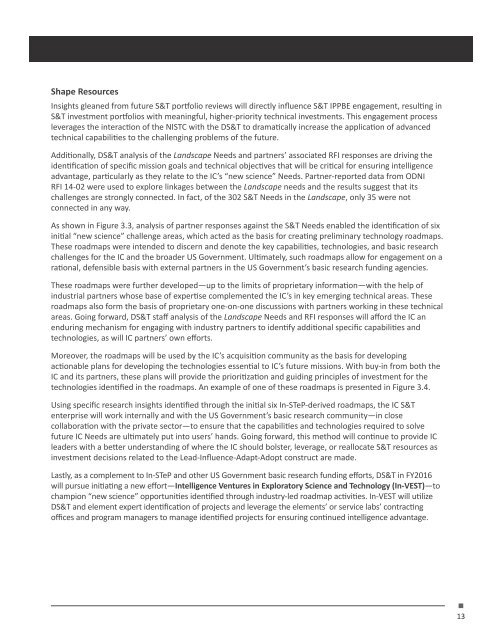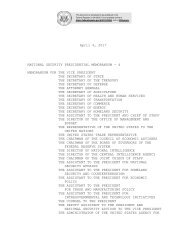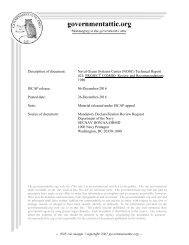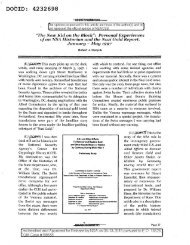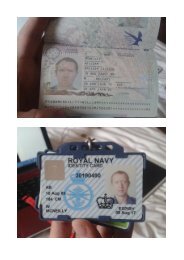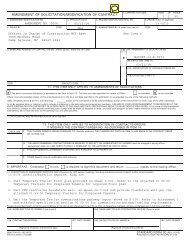FY2016-2020 <strong>IC</strong> S&T STRATEG<strong>IC</strong> <strong>PLAN</strong>: MANAGING RISK TO ENSURE INTELLIGENCE ADVANTAGEactivities across participating <strong>IC</strong> elements. Accordingly, DS&T and the NISTC will move in FY2016 toinstitutionalize new mechanisms to coordinate pre-operational R&D efforts related to cross-Communitychallenges, thereby freeing up FMs’ resources to accelerate current programs or confront additionalchallenges within their functional areas.The Landscape and the Partner Response provide unprecedented insight into both <strong>IC</strong>-wide challengesand potential technical solutions, and will inform <strong>IC</strong> S&T strategic planning and the discussions during theannual element portfolio reviews. A primary goal of future portfolio reviews will be to inform <strong>IC</strong> enterpriselevelprogram planning in support of the Needs listed in the Landscape. This may include informing theIPPBE process, identifying and resolving cross-program dependencies, recommending budget changes,and evaluating execution ability and performance. Ultimately, basing the annual portfolio reviews on theLandscape Needs will help ensure that <strong>IC</strong> element S&T investment portfolios combine to form a morecomprehensive, integrated <strong>IC</strong> investment portfolio.Develop and Protect Disruptive Capabilities To Meet <strong>IC</strong> NeedsIn-STeP is designed to capture Community-wide Needs and assign responsibility to the relevant FMs toprovide a solution, as aided by partners. However, additional organizations and non-requirements drivenentities are also needed to provide the flexibility to operate outside of this mainstream process. Thismeasure of flexibility enables these entities to develop truly disruptive solutions that may not be possiblewithin a larger organization with traditional business models.ODNI’s Intelligence Advanced Research Projects Activity (IARPA) is one way to collaborate across the<strong>IC</strong> to develop novel methods and technologies to ensure its research addresses relevant future needs.This Community-wide focus ensures IARPA’s ability to address cross-agency challenges, leverage cross-<strong>IC</strong>operational and R&D expertise, and coordinate transition strategies with our agency partners.DS&T Strategic StudiesIn addition to identifying technical challenges for individual <strong>IC</strong> FMs—as well as those challenges on whichthey need to collaborate—the first iteration of the Landscape identified a number of “new science”Needs that will be the focus of future DS&T-led initiatives to organize, plan, and execute coordinatedefforts. The majority of these new areas of understanding will require leveraging partners outside of theNIP, such as the National Science Foundation and the National Academies of Science. These efforts willbuild on current or previous DS&T efforts to “change the business model” in a variety of areas, such asvideo analytics and identity intelligence.A key challenge for the <strong>IC</strong> S&T enterprise when developing disruptive technologies is balancing the oftennecessary need for open, unrestricted scientific collaboration with the global research community and theneeds of national security. Security and counterintelligence must play a significant role in all aspects of the<strong>IC</strong> S&T research enterprise if the US is to exploit its hard-earned technical advantages. The Research andTechnology Protection (RTP) process, developed and implemented at IARPA, represents a best practice forachieving this balance. The RTP process provides a systematic and reproducible comprehensive security andtechnology protection framework for all funded research activities. It identifies threats to S&T initiativeswhich could compromise research, place the US at a technological disadvantage, or compromise our nationalsecurity. Moreover, determining the protection framework at the very onset of a research activity ensuresappropriate, consistent, classification decisions and defines the extent to which participation from nontraditionalsources such as academia, small businesses, and international organizations can be allowed.12
Shape ResourcesInsights gleaned from future S&T portfolio reviews will directly influence S&T IPPBE engagement, resulting inS&T investment portfolios with meaningful, higher-priority technical investments. This engagement processleverages the interaction of the NISTC with the DS&T to dramatically increase the application of advancedtechnical capabilities to the challenging problems of the future.Additionally, DS&T analysis of the Landscape Needs and partners’ associated RFI responses are driving theidentification of specific mission goals and technical objectives that will be critical for ensuring intelligenceadvantage, particularly as they relate to the <strong>IC</strong>’s “new science” Needs. Partner-reported data from ODNIRFI 14-02 were used to explore linkages between the Landscape needs and the results suggest that itschallenges are strongly connected. In fact, of the 302 S&T Needs in the Landscape, only 35 were notconnected in any way.As shown in Figure 3.3, analysis of partner responses against the S&T Needs enabled the identification of sixinitial “new science” challenge areas, which acted as the basis for creating preliminary technology roadmaps.These roadmaps were intended to discern and denote the key capabilities, technologies, and basic researchchallenges for the <strong>IC</strong> and the broader US Government. Ultimately, such roadmaps allow for engagement on arational, defensible basis with external partners in the US Government’s basic research funding agencies.These roadmaps were further developed—up to the limits of proprietary information—with the help ofindustrial partners whose base of expertise complemented the <strong>IC</strong>’s in key emerging technical areas. Theseroadmaps also form the basis of proprietary one-on-one discussions with partners working in these technicalareas. Going forward, DS&T staff analysis of the Landscape Needs and RFI responses will afford the <strong>IC</strong> anenduring mechanism for engaging with industry partners to identify additional specific capabilities andtechnologies, as will <strong>IC</strong> partners’ own efforts.Moreover, the roadmaps will be used by the <strong>IC</strong>’s acquisition community as the basis for developingactionable plans for developing the technologies essential to <strong>IC</strong>’s future missions. With buy-in from both the<strong>IC</strong> and its partners, these plans will provide the prioritization and guiding principles of investment for thetechnologies identified in the roadmaps. An example of one of these roadmaps is presented in Figure 3.4.Using specific research insights identified through the initial six In-STeP-derived roadmaps, the <strong>IC</strong> S&Tenterprise will work internally and with the US Government’s basic research community—in closecollaboration with the private sector—to ensure that the capabilities and technologies required to solvefuture <strong>IC</strong> Needs are ultimately put into users’ hands. Going forward, this method will continue to provide <strong>IC</strong>leaders with a better understanding of where the <strong>IC</strong> should bolster, leverage, or reallocate S&T resources asinvestment decisions related to the Lead-Influence-Adapt-Adopt construct are made.Lastly, as a complement to In-STeP and other US Government basic research funding efforts, DS&T in FY2016will pursue initiating a new effort—Intelligence Ventures in Exploratory Science and Technology (In-VEST)—tochampion “new science” opportunities identified through industry-led roadmap activities. In-VEST will utilizeDS&T and element expert identification of projects and leverage the elements’ or service labs’ contractingoffices and program managers to manage identified projects for ensuring continued intelligence advantage.13


